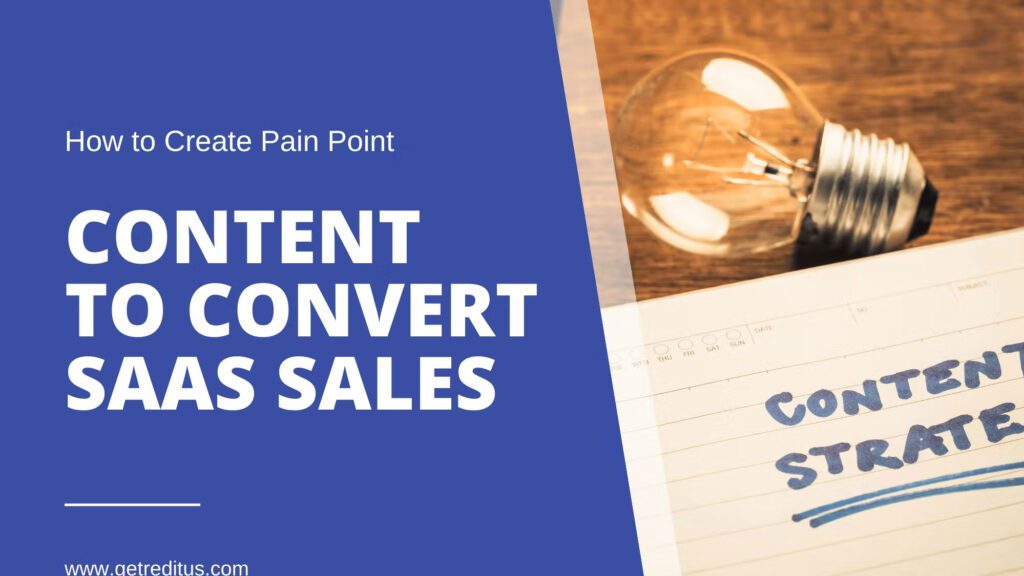How to Create Pain Point Content to Convert SaaS Sales

Most B2B SaaS companies know the significance of speaking to customers through marketing the customer's pain points. However, successfully performing practical ideas can be challenging.
Since these marketing ploys can be challenging to implement, many businesses prefer to focus on their SaaS product features and benefits in their content.
You might ask, what's wrong with that?
The problem is a missed opportunity. The best method to create higher converting content from your foundational SaaS website pages is to utilize your customer's pain points in your content marketing.
The basis of pain point content converting at a higher rate is straightforward. When you can relate how your product features solve critical issues that your potential clients experience, the value of your product becomes transparent and convincing.
When you only focus on advantages, you depend upon the features to make the connection on their own. Being explicit with messaging will help the new customer see how the feature solves their problem.
Creating marketing with the problems highlighted is much easier said than done, but how do you persuasively do this?
This article will discuss practical advice on incorporating pain points into three critical types of B2B SaaS content.
Table of contents

Test Your Conversion Potential of Pain Point Content
In my experience with SaaS marketing, I tested the conversion rates between the top of the funnel, TOFU, non-pain point content, and the bottom of the funnel, BOFU, pain point content.
I suggest you test this with your market too. I will outline how I did this so you can replicate the test and hopefully increase your sales in the process.
To do this, you can create two types of articles. One should be a TOFU guide targeting a specific keyword. I utilized "What is the net promoter score?" as my keyword. The other was a BOFU pain point article on "how to create a survey."
Obviously, I was anticipating the BOFU piece to convert higher, but the capacity to which it did surprise me.
The TOFU guide converted few sales, even though the traffic volume was increasing. We ranked on the first page during that cycle. However, the BOFU pain point article unfailingly converted 20% of all traffic into customers.
Six months after publication, one article consistently generates between 100-150 signups per month.
How to Create Pain Point Content?
At this point, you should realize the basis of this content is pain point marketing. You were looking for a solution to your marketing problem and found this article.
So obviously, since you are here, the market solution works. The following are three types of pain point content we found to be most effective for B2B SaaS.
Three types of pain point content that convert in B2B SaaS
1. Competitor comparison pages
Competitor comparison pages are critical aids for any B2B SaaS company in a competitive market. They perform great for both SEO and sales enablement.
Exemplary examples are pages like:
When people explore comparisons like these, there are two layers of pain points they are attempting to decipher. They want to figure out:
- What are the distinctions between two products or services?
- Which option is going to better solve my specific pain points? Which solution is best for my business?
Distinguished competitor comparison pages should communicate the answers to both these questions.
Through these sections, we can address both layers of pain points for readers. Writing about the specific problems product A solves for users and who the ideal end user is.
Therefore, the content will be search engine optimized for your audience and the solution to their problem.

2. "How to" blog posts
Blog posts with a "How to" title are a classic form of pain point content. When an individual searches for how to do something, this indicates they have a problem needing a solution.
In B2B SaaS, the formula to produce a great product is identifying specific problems. Therefore when you market your product, you want to discuss the problem your product solves.
Connect 365 creates lead management software. One of the primary problems they help their customers solve is improving developments from prospecting.
So a fantastic article they wrote was titled "How to Obtain More Clients through Prospecting."
The strategy for this kind of "how to" content does not need to be complicated. It must have two key components:
- Express the pain you solve so candidates can immediately connect to your brand
- Describe how your product resolves the pain point, or link to a page to explain the solution in depth
In the body paragraphs explaining how each tactic works, it is essential to tie the product's solution with corresponding links. Therefore they can learn more about how the solution meets their needs.
The linking lets visitors quickly navigate to a page that provides in-depth content about your SaaS solutions. Continuing to tie specific pain points to a particular solution will help you communicate to your audience a clear connection between acute problems they experience and how your product works to solve them.
3. "Alternatives to" pages
"Alternatives to" pages are remarkably analogous to competitor comparison pages. Sometimes they are the same.
However, "Alternatives to" pages are usually done as list-style posts. In these articles, you list several options for a competitor, including your own. Then you describe how these competitors differ.
One thing to mention is the likely difference in purpose.
When someone types in "X company + alternative," it is possible that they are presently unsatisfied with the specific product. Therefore they are seeking a different answer that their previous product did not solve. In this case, that discontent is one of their pain points.
So again, like comparison pages, there are numerous layers of pain points to manage. One layer to the discussion is answering how your product's solution to pain points. The second layer is the pain points people have with their current solution. Effective alternative pages should address your product's answers and the pain points your audience experiences.
The Bottom Line
In this post, I've highlighted 3 of the most effective types of pain point content for B2B SaaS. However, these are not the only kinds of pain point content you can create.
Incorporating pain points into your marketing goes beyond content. It would help if you weaved them into your overarching SaaS marketing strategy involving your positioning, PPC, and SEO.
Companies that use this approach are winning more customers by being clear about the problems they solve.

